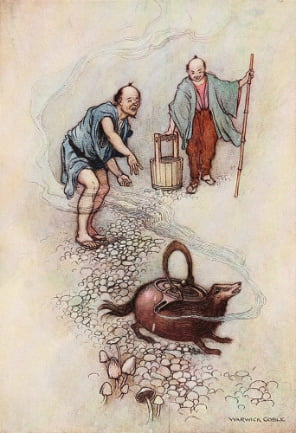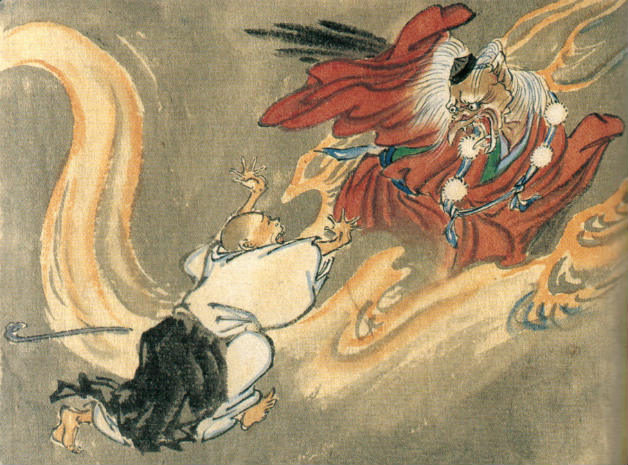Japanese Fairy Tales, Folk Tales and Fables

The Tea Kettle by Warwick Gobble. Published in Green Willow and Other Japanese Folk Tales by Grace James, (1910).
Read Japanese fairy tales by Yei Theodora Ozaki, and from the collections of Grace James and Matilda Chaplin Ayrton. Jump to full list of Japanese tales.
About: Japanese folklore has remained a topic of interest for people across the world. Many stories that originated from Japan have inspired horror movies, graphic novels, anime, manga, and books, often because the stories’ characters make a lasting impression. An interest in Japanese culture and enthusiasm for sharing their traditions with other countries led to the publication of several books in the earlier 20th century, including Green Willow and Other Japanese Fairy Tales by Grace James and Child-Life in Japan by Matilda Chaplin Ayrton. Both were authored by women who weren’t native citizens of Japan, but had come to the country and fell in love with the culture. Author William Elliot Griffis wrote Japanese Fairy World, a collection of fairy tales and folk tales arriving in Japan in 1870 to reach English; the book was also published as The Fire-fly’s Lovers and Other Fairy Tales of Old Japan. The culture wasn’t without its own authors, however, as author Yei Theodora Ozaki, was of Japanese heritage. She translated Japanese texts, and added elements of the local area to bring the stories alive for readers.
Much of the folklore and fairy tales of Japan are influenced and inspired by their religious beliefs, Shinto and Buddhism; however, the Japanese folklore canon also takes some of its influences from other countries’ literature, such as the stories of ancient India. The characteristics of the folk tales are varied, but like The Grimm Brothers and stories of other famous storytellers, the folk tales from Japan feature themes like kindness, magic, and greed. Japanese folklore also include supernatural stories featuring creatures, spirits and monsters, many of which have characteristics of nature.
Similar to the folklore of Germany and France, Japanese folk tales began in the oral tradition and were eventually penned down for posterity. The oldest known chronicle from Japan is the Kojiki. Many tales originate from this collection of myths, which was published around 711 A.D. One popular form of storytelling of myth and folklore in Japan was known as Kamishibai, or “paper drama.” Kamishibai became particular popular in the 1920’s through the 1950’s, though it existed much earlier. The storytelling format would use picture scrolls or illustrated boards to tell a moral lesson in front of the townspeople of a local village; often the storyteller would return for a new installment of the story.
Listen to Japanese fairy tales and folktales plus hundreds of other fairy tale audiobooks in the Fairytalez Audio Book App for Apple and Android devices.
- The Bamboo-Cutter and the Moon-Child
- The Beautiful Dancer of Yedo
- Broken Images
- The Bell of Dojoji
- The Black Bowl
- The Chrysanthemum Show
- The Crab and the Monkey
- The Creation of Heaven and the Earth
- The Child of Thunder
- The Cat's Elopement
- The Cold Lady
- First Month
- The Farmer and the Badger
- The Flute
- The Filial Girl
- The Fire Quest
- The Fire-Fly's Lovers
- Flower of the Peony
- The Fox and the Badger
- Fishsave
- How an Old Man Lost His Wen
- Hana-Saka-Jiji
- The Happy Hunter and the Skillful Fisher
- How the Sun Goddess Was Enticed Out of Her Cave
- Horaizan
- Karma
- The Mirror of Matsuyama
- The Maiden with the Wooden Helmet
- The Moon Maiden
- My Lord Bag of Rice
- Momotaro, or the Story of the Son of a Peach
- The Maiden of Unai
- The Magic Kettle
- The Matsuyama Mirror
- Momotaro
- The Mallet
- The Stones of Five Colors and the Empress Jokwa
- The Seven Patrons of Happiness
- Schippeitaro
- The Story of Princess Hase
- The Stone-Cutter
- The Slaying of the Tanuki
- The Sea King and the Magic Jewels
- The Story of the Old Man Who Made the Withered Trees to Flower
- The Sagacious Monkey and the Boar
- The Star Lovers
- The Story of Susa, the Impetuous
- The Story of the Man Who Did Not Wish to Die
- Second Sight
- The Shinansha, or the South Pointing Carriage
- The Story of Urashima Taro, the Fisher Lad
- The Singing Bird of Heaven
- The Sad Story of the Yaoya's Daughter
- The Spring Lover and the Autumn Lover
- The Story of Prince Yamato Take
- The Strange Story of the Golden Comb
- Tamamo, the Fox Maiden
- The Tea-Kettle
- The Tengus or the Elves with Long Noses
- The Tongue-Cut Sparrow
- The Tongue-Cut Sparrow
- Two Frogs
- The Two Daughters

